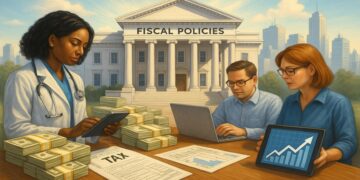Economic Inequality in the USA: Causes and Proposed Solutions

Understanding Economic Inequality
In contemporary America, economic inequality has emerged as a pivotal issue, shaping the lives of millions. The gap between the wealthy and the less affluent has not only grown wider but also sparked considerable debate and concern among economists, political leaders, and citizens alike. Understanding this complexity requires examining various factors and possible resolutions.
One significant driver of economic inequality is education access. Limited opportunities for quality education often perpetuate cycles of poverty, making it difficult for individuals from low-income backgrounds to secure high-paying jobs. According to a report from the U.S. Census Bureau, individuals with a bachelor’s degree can earn significantly more over their lifetimes compared to those without one. This not only emphasizes the importance of higher education but also raises questions about the accessibility of such educational opportunities in underserved communities.
The dynamics of the job market also play a critical role. Automation and outsourcing have drastically transformed the employment landscape, disproportionately affecting lower-wage jobs. For instance, industries such as manufacturing have seen a decline in domestic jobs as companies move operations overseas or replace human labor with machines. As a result, many workers find themselves trapped in low-paying service jobs that offer little potential for upward mobility.
Tax policies further exacerbate economic inequality. Structural tax benefits tend to favor the wealthy, creating a system where the richest households can accumulate wealth more rapidly than the middle and lower classes. The Tax Policy Center highlights how the top 1% of earners hold a significant portion of the nation’s wealth, raising concerns about fair taxation and equitable economic participation.
Another pressing issue relates to healthcare costs. The rising expenses associated with healthcare can overwhelm lower-income families, siphoning off funds that might otherwise be used for education or savings. The American Journal of Public Health reported that medical bankruptcies remain a leading cause of financial distress among working-class families, highlighting the direct correlation between health and financial stability.
Addressing Economic Inequality
As the divide continues to expand, the need for thoughtful solutions becomes more pressing. Potential strategies to address economic inequality include:
- Progressive Tax Reforms: Revising tax codes to lessen the burden on the lower and middle classes can help redistribute wealth more effectively. For example, implementing higher taxes on capital gains could provide necessary funding for social programs that benefit all citizens.
- Universal Basic Income: Exploring financial support mechanisms, such as a universal basic income, could provide a safety net for all citizens, ensuring that basic needs are met regardless of employment status. Pilot programs in various states have shown promise in reducing poverty levels.
- Education and Job Training: Investing in affordable education and vocational training programs is essential for equipping individuals with skills that are relevant in the modern job market. Community colleges and online learning platforms present opportunities for upskilling that can bridge the wage gap.
These proposed solutions aim to instigate a broader conversation about how America can navigate its path toward economic equity. By exploring these causes and potential remedies, we not only inform policy discussions but also empower individuals to make informed financial decisions that can shape their futures.
The Roots of Economic Disparity
The complexity behind economic inequality in the USA can be attributed to a multitude of intertwining factors. One major contributor is wage stagnation. Over the past few decades, while the cost of living has steadily increased, wages for many middle and lower-income workers have remained relatively stagnant. According to the Economic Policy Institute, the typical worker’s wage has barely seen an increase when adjusted for inflation since the late 1970s. This stagnation, coupled with rising living expenses, has pushed many families into precarious financial situations.
Additionally, advancements in technology have disrupted traditional job markets. The rise of the digital economy has led to the creation of high-skilled, high-paying jobs, while simultaneously marginalizing low-skilled positions. An analysis from the World Economic Forum suggests that approximately 85 million jobs could be displaced by automation by 2025. This shift requires workers to adapt continually, yet many lack the necessary resources or training to do so, exacerbating the wealth gap.
Another layer of this issue is rooted in geographical disparities. Economic opportunities can vary drastically depending on one’s location. Urban areas, particularly technology hubs such as Silicon Valley and New York City, are witnessing a boom in wealth creation. In contrast, rural areas and economically depressed regions are struggling with unemployment and dwindling job prospects. The U.S. Bureau of Economic Analysis reports that regions in the Midwest have faced a recession-like impact, damaging long-standing industries and leaving workers with few alternatives.
The issue of inheritance and wealth accumulation also cannot be overlooked. Research by the Federal Reserve indicates that wealth is disproportionately concentrated among inherited assets. The wealthiest households, often with generational advantages, continue to accumulate resources, whereas lower-income families can struggle to build even modest savings. This cycle fosters an environment where the rich can invest in education, business ventures, and other wealth-generating activities, widening the gap between economic classes.
Moreover, the impact of systemic racism and discrimination cannot be ignored when discussing economic inequality. Marginalized communities often face barriers to employment, education, and housing that limit their financial prospects. The median net worth of Black and Hispanic households remains significantly lower than that of white households. According to the Federal Reserve’s Survey of Consumer Finances, this disparity in wealth is rooted in longstanding institutional factors and social inequities that perpetuate the cycle of poverty.
Understanding the Implications
Recognizing these underlying causes is crucial for addressing economic inequality effectively. By unpacking the complexities of wage stagnation, technological advancements, geographic disparities, inheritance, and systemic racism, we can begin to understand the broader implications of economic inequality on society as a whole. Each of these factors not only affects individual lives but also impacts economic growth and social cohesion. The pressing need for targeted policies that account for these intricacies is vital for paving the way toward a more equitable future.
The Social Implications of Economic Inequality
Beyond the immediate financial consequences, the social implications of economic inequality can have long-lasting effects on communities and the nation as a whole. With significant portions of the population grappling with economic hardship, issues such as poor health outcomes and reduced access to education are amplified. A report from the Robert Wood Johnson Foundation illustrates that individuals living in lower-income neighborhoods often face higher rates of chronic diseases, limited access to quality healthcare, and, subsequently, lower life expectancies. The inability to afford healthcare or live in a healthy environment creates a cycle of illness that impedes economic mobility.
Moreover, educational attainment serves as a critical determinant of future income potential, yet access to quality education is severely stratified in the United States. According to the National Center for Education Statistics, students in low-income districts receive funding nearly one-third less than their middle-class counterparts. This funding gap results in overcrowded classrooms, outdated materials, and inadequate resources, which ultimately hinders students’ progress. The opportunity to secure a college education, which is often viewed as a gateway to higher earnings, becomes increasingly unattainable for many.
The psychological ramifications of economic disparity also bear consideration. Research published in the Journal of Health and Social Behavior indicates that economic inequality can lead to feelings of hopelessness, anxiety, and depression among lower-income individuals. The constant stress of financial insecurity not only affects one’s mental health but can also strain interpersonal relationships and diminish social cohesion within communities. When wealth is concentrated in the hands of a few, the fabric of trust and cooperation that communities rely on becomes frayed, leading to increased social unrest.
In light of these multifaceted issues, various policy interventions and solutions have been proposed to address economic inequality. One frequently suggested measure is the implementation of a universal basic income (UBI), which would provide all citizens with a fixed, unconditional sum of money to help cover basic living costs. Proponents argue that this could help alleviate poverty and stimulate local economies, while opponents worry about its potential effect on the workforce and tax burdens. Nonetheless, pilot programs in cities like Stockton, California, have demonstrated promising results, showing that recipients use UBI funds to create economic opportunities and improve their financial well-being.
Another approach gaining traction is the expansion of affordable housing policies. As housing costs continue to swell, many families find themselves devoting an overwhelming portion of their incomes to rent, which leaves little left for other necessities. Initiatives to increase affordable housing availability, such as tax incentives for developers, may help alleviate housing pressure, allowing low- and middle-income families to build savings and improve their financial conditions.
Furthermore, progressive taxation could serve as an effective tool to alleviate disparities. By adjusting tax rates to ensure that wealthier individuals contribute a larger percentage of their income, the government could generate additional revenues for public services and social programs. This approach not only addresses fiscal needs but may also contribute to reducing wealth concentration over time.
As discussions surrounding economic inequality gain prominence, it’s important for citizens, policymakers, and stakeholders to consider the implications of these strategies carefully. The road ahead calls for innovative solutions that can bridge the growing divide, ensuring that economic opportunities are available for all Americans, regardless of their background.
Conclusion
In sum, the issue of economic inequality in the United States is not merely a statistic but a complex tapestry woven with social, health, and educational threads. As we have explored, the causes are multi-faceted—ranging from wage stagnation and job displacement to systemic issues rooted in education and access to healthcare. Each factor feeds into a broader narrative of disparity that affects millions, making it imperative to seek out innovative and effective solutions.
Proposed interventions, including universal basic income, affordable housing policies, and progressive taxation, present tangible avenues for addressing these inequities. Programs like UBI have shown promise in pilot tests, revealing they can help individuals escape poverty while stimulating local economies—an outcome that could herald a new era of economic opportunity. Likewise, ensuring adequate funding in low-income education districts and expanding housing policies could empower families to break the cycle of poverty, fostering a new generation with the tools and resources to contribute substantially to the economy.
The path forward will require a concerted effort from policymakers, stakeholders, and communities to bridge the widening economic chasm. By recognizing the intricate connections between economic inequality and its broader implications, we can begin to formulate strategies that not only address the symptoms of this inequity but also tackle the root causes effectively. The pursuit of economic justice must remain a priority—not just for the sake of equity, but as a means to cultivate a healthier, more prosperous society for all Americans. The time for action is now, as the consequences of inaction will only deepen the divides and diminish the potential of future generations.

James Carter is a financial writer and consultant with expertise in economics, personal finance, and investment strategies. With years of experience helping individuals and businesses navigate complex financial decisions, James provides practical insights and analysis. His goal is to empower readers with the knowledge they need to achieve financial success.





